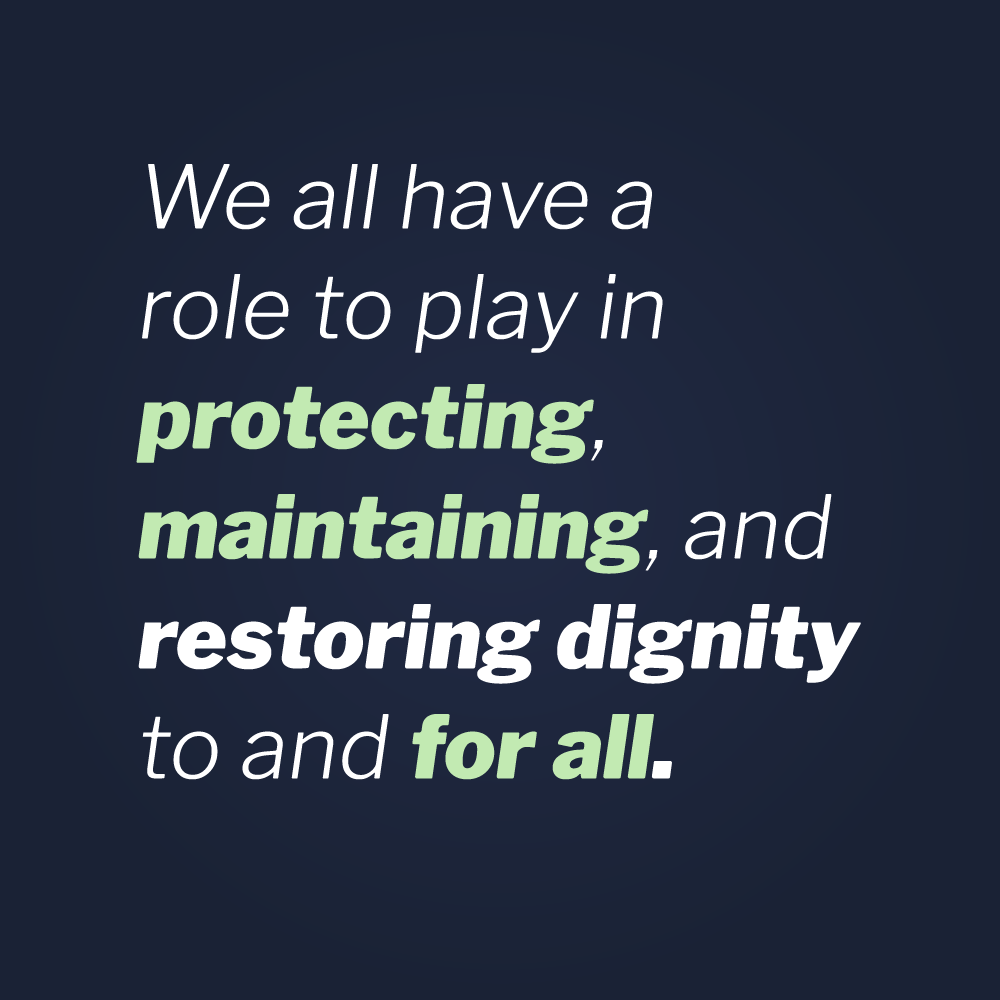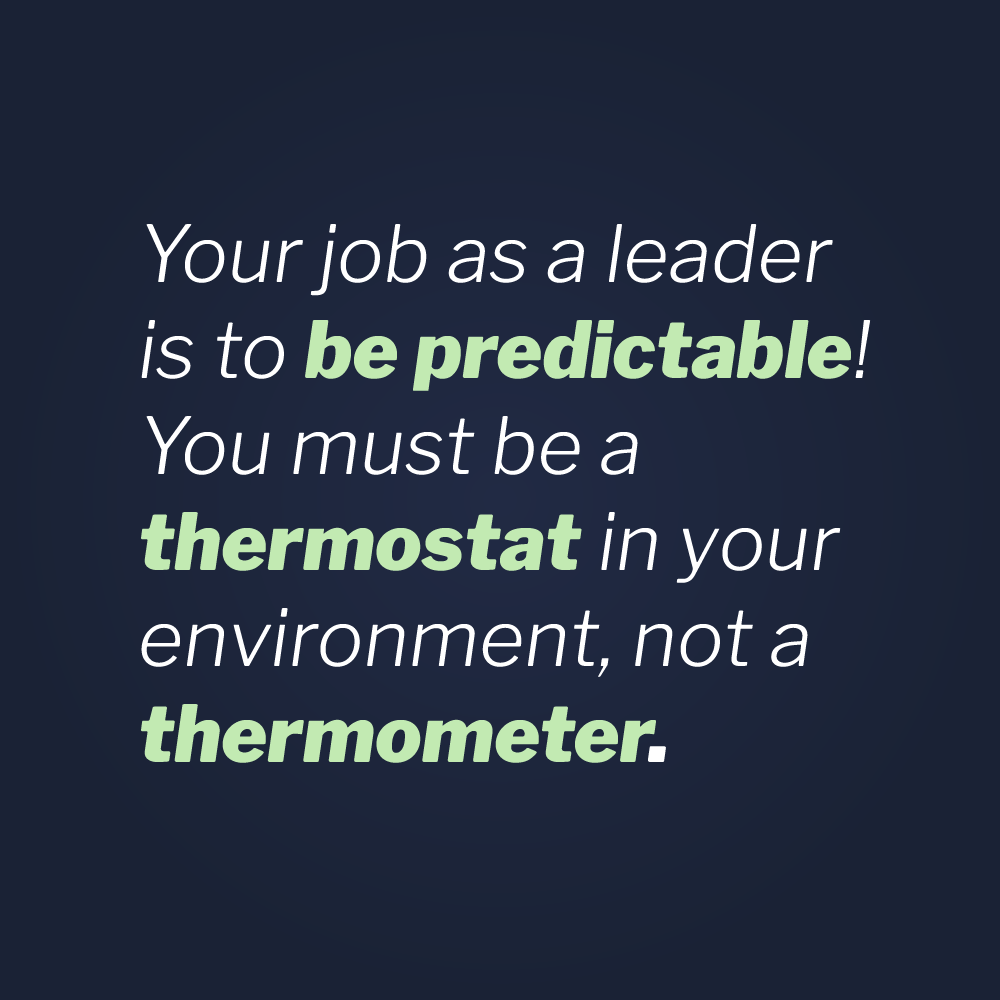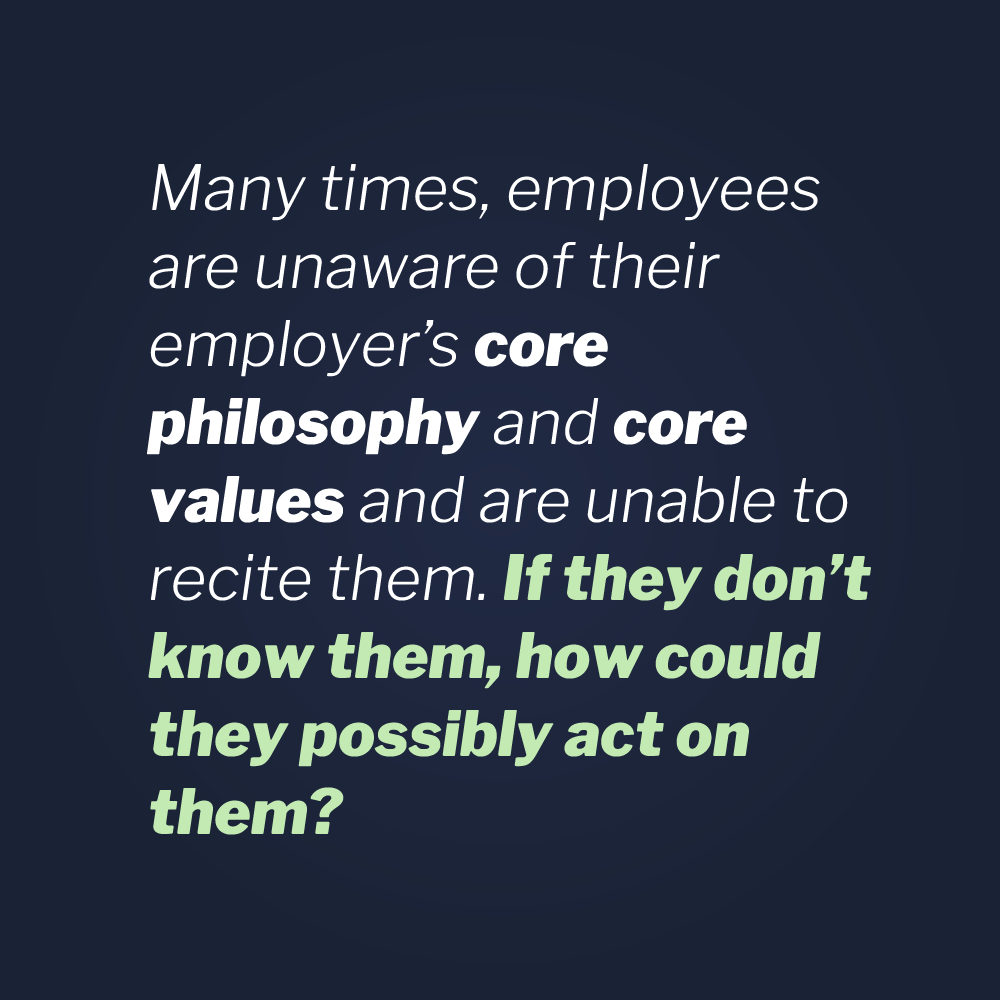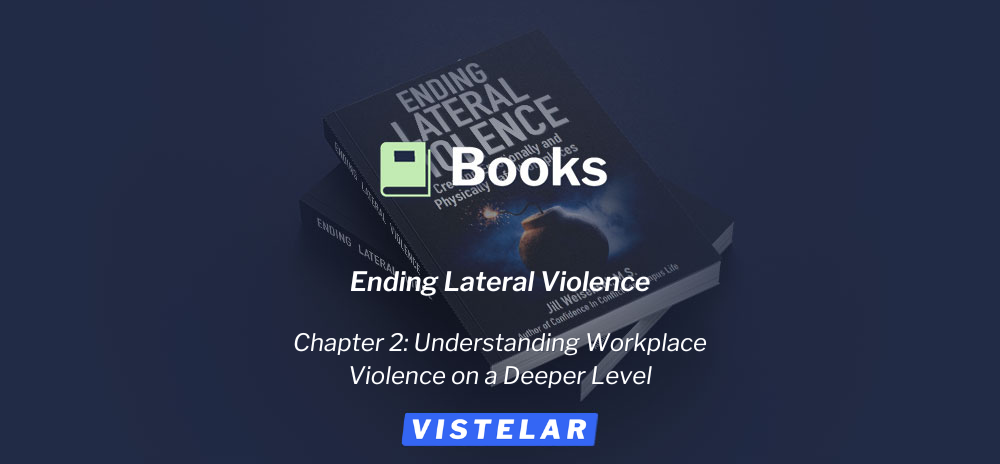Enjoy this excerpt from one of our published books.
Chapter 3
Creating an environment that is incompatible with emotional and physical violence
“Act as if what you do makes a difference. It does.”
– William James, philosopher and father of American psychology
In an analysis of 1.4 million Glassdoor reviews about company culture from people who have left their jobs, researchers Charlie and Donald Sull found what they call the “Toxic 5,” the top themes that create a toxic corporate culture:
- Lack of inclusion. Being non-inclusive or condoning an environment where people feel as if they are not being treated fairly because of their identity.
- Disrespect. Being disrespected or feeling as if they are not respected.
- Unethical behavior. Engaging in unethical behavior, such as dishonesty, lack of integrity, or failing to act within policy.
- Cutthroat behavior. Engaging in cutthroat behavior, or people actively going out of their way to undermine or sabotage others
- Abusive Managers. Having abusive managers, those who overly criticize, discriminate, micromanage, and gaslight.
These five themes are above and beyond the more minute things people “grumble” or complain about at work. They are collectively, by far, the largest predictors of destroying quality of life and driving talented people out the door.
So then, to create a healthy workplace culture, we must first work to ensure we are not participating in or perpetuating any of those behaviors, or any of the behaviors mentioned in previous chapters.. Then secondly, we must work to build a collective environment that will not allow these behaviors to exist. We must build a value-based culture based on respect, integrity, diversity, and collaboration.
we must work to build a collective environment that will not allow these behaviors to exist. We must build a value-based culture based on respect, integrity, diversity, and collaboration.
We all have a role to play in protecting, maintaining, and restoring dignity to and for all.
Creating an environment that is incompatible with emotional and physical violence will take a completely mobilized community, one that embraces a shared sense of social responsibility and is motivated by a new core philosophy: treating all people with dignity by showing respect.
Culture drives behavior, and behavior drives outcomes. Habits, good or bad, do not just exist at the individual level. When replicated across a group, habits create culture. By creating a shared culture of civility, you will drastically improve your team’s willingness to help, creativity, and resource sharing.
If we are working to build a safer and more respectful community culture, the first question we must ask ourselves is, “Whose behavior are we trying to change?”
The answer is: Ours. Us. All of us. We all have a role to play.
It isn’t just about your business, your individual title, or your specific role. Eradicating laterally violent behaviors is about the entire process. And that process of developing and maintaining your social contract, your core philosophy, your culture, and your brand includes your entire organizational community. For each member, it has to be about being a part of something greater than themselves, finding a way to contribute, and finding a way to champion the common good.
At every juncture of that process, that journey—whether it involves a customer, client, or employee—we must work to meet, exceed, and reinforce that culture.
Every interaction with someone is understood as an opportunity to build or destroy trust, and every piece of service delivery matters to the overall experience and performance within the organization. There are multiple moments and multiple touchpoints throughout the journey that will involve every individual that interfaces with them, including all of the contributions from the employees that you don’t “see,” the back-of-the-house-type staff who provide crucial services. So here, to reinforce this point, just like security and safety are everybody’s business, so is the way in which you and your co-workers interface with the public on a daily basis. For example, when people come to your organization with a question, they look for people who look like they work there to answer it; they don’t care whether your employee works in customer service or not.
They don’t care about their title. Or their specific role. All they care about is getting an answer to their question or getting a resolution to their problem. And to that end … Everyone has a role to play in that service delivery, in living up to your promise, to your brand, and to your organizational reputation.
People will remember any part of the journey where that promise was not met. From the moment they walk in and judge how the place looks, to the first person they see and interact with, to the janitorial staff and the lunchroom staff, to the administrative staff, faculty, specialized staff, and all of those employees, including and up to the leadership in the C-suite. Everyone has to live up to that promise, brand, and culture. Living up to that promise is everybody’s business.
The bottom line is that we all have to be part of the solution, or we very well could be part of the problem. Remember:
- What you permit, you promote.
- Doing nothing is never a neutral option.
- Nothing changes if nothing changes.
“This is a story about four people named Everybody, Somebody, Anybody, and Nobody. There was an important job to be done and Everybody was sure that Somebody would do it. Anybody could have done it, but Nobody did it. Somebody got angry about that, because it was Everybody’s job. Everybody thought Anybody could do it, but Nobody realized that Everybody wouldn’t do it. It ended up that Everybody blamed Somebody when Nobody did what Anyone could have.”
– Author unknown
Building a Culture of Shared Social Responsibility
The following section outlines action steps you can take to build a culture of shared social responsibility. The steps include:
- Mobilizing the strong opinion leaders.
- Assessing community readiness.
- Building a primary prevention and behavior change platform.
- Creating a new social contract.
Step One: Mobilizing the Strong Opinion Leaders
The first step in creating a culture of shared social responsibility is to mobilize the strong opinion leaders, the role models, and leaders (both formal and informal) within your organization.
Think about it: How many times have you walked into a store or school and noticed the “hate-free zone” or “bully-free zone” sign on a wall? Yet, there are still plenty of hateful and harmful actions taking place and disrespectful comments being made in the space.
While there’s a time and place for signage, awareness-raising alone does not lead to behavior change. The “hate-free zone” sign on the wall doesn’t stop the behaviors from happening. It is the ethical presence of those in the room that stops those behaviors from happening.
“Bullying cannot systemically exist within an organization or group without the consent, cooperation, and participation of the leadership.”
– Joel Lashley
Strong opinion leaders educate their circle of influence, and that circle will educate theirs, and so on. For a complete cultural shift to take hold, it has to be completely understood, accepted, and implemented through a top-down approach. It has to be addressed at all levels of the organization, and leaders must draw a hard line in the sand and become intolerant of any behaviors falling below that line. The goal is to stop all behaviors that are harming others. Period.
This may truly be the most critical point of this book: To raise expectations and implement true organizational change, you need strong leadership. But what does strong leadership look like?
Ethical Presence and Credibility of Character
Strong leaders—those who can be trusted, believed, respected, and heard—are both ethical and credible. They must have a highly professional bearing that drives standards of excellence. It is that bearing—that person’s presence—that raises the standards and expectations for all the people in the room and everyone in the organization.
Always be responsible for the energy you bring into a space.
As a leader who trains other leaders, I remind you that “lead” is a verb and leadership actions must be intentional. The first form of leadership is self-leadership. Your goal is not to create followers; it is to create more leaders. I implore you to reflect on the following questions as they relate to the need for ethical presence and credibility of character:
- Are you setting your best foot forward and consistently representing the most professional version of yourself?
- When you walk into a room, does it get better or worse? Does it get emotionally and physically safer for everyone there, or not?
- When you walk into a room, are people happy you are there? Do they change their behavior (for better or worse) because of your presence?
- Are they safer because you are there?
“Leadership is about making others better as a result of your presence and making sure that impact lasts in your absence.”
– Sheryl Sandberg, past Chief Operating Officer at Facebook
A Note About the Importance of Creating a Supportive Atmosphere
Employees will not be able to talk through anything effectively if they feel threatened in any way and/or enter a defensive state of being. The company at which I work, Vistelar, trains how to maintain your emotional equilibrium, even in the face of physical and mental stressors.
Physical stressors can range from:
- Environmental conditions such as hot/cold/wet, noisy, bright, or strong odors.
- Physiological conditions such as sleep deprivation, dehydration, and malnutrition.
And mental stressors range from:
- Cognitive stressors such as too much or too little sensory overload, isolation, uncertainty, unpredictability, and varying organizational dynamics.
- Emotional stressors such as fear, anxiety-producing threats, grief, resentment, boredom, frustration, and conflicting motives.
It is critical when having courageous, crucial, or critical conversations with people that you take into account their state of being. Are they calm, relaxed, and balanced? Or are they stressed, uncomfortable and imbalanced? You must do everything possible to ensure they remain in a calm, balanced state of being, or they literally—physiologically and emotionally speaking—will not be able to communicate effectively. Plainly put, when a person feels unsafe, they become defensive. And when they feel disrespected, they can easily go on the offensive.
Here’s why:
When we feel threatened, regardless of the stressor, our body’s fight or flight stress response kicks in, triggering an entire cascade of emotional, physiological, and psychological effects. Presenting all of these effects is beyond the scope of this book, but it is important to note that when the fight or flight response kicks in:
- Our heart rate goes up and our ability to think logically goes down.
- Our breathing rate and blood pressure increase while our fine concentration decreases.
- Our openness to new ideas is reduced and our thinking becomes muddled.
- Our interpersonal communication becomes defensive.
Even if you “do everything right,” the person you are speaking with may become defensive. However, it is imperative that you maintain communication alignment and convey a message of respect and sincerity throughout your interaction to give you (and them) the best chance of a successful and professionally positive outcome. To maintain communication alignment, all of your proxemics (distance), non-verbals (expressions and other body language), verbals (word choices), and para-verbals (tone and volume of voice) must match your intended message. If you intend to show empathy, but your facial expression shows irritation, it won’t matter how sincerely you try to deliver your words. For more information on any of these concepts, please reference the section titled “Who is Vistelar” at the end of the book.
Modeling Behaviors and Behavioral Regulation
As Eleanor Roosevelt once said, “It is not fair to ask of others what you are unwilling to do yourself.” Fellow employees will only do what you ask them to do when they believe in you.
Modeling behavior is key.
When a leader models the right behavior, is explicit in their expectations for behavior and consistently follows through in the management of behaviors, they help you construct a new social contract - a new set of agreed-upon and acceptable behaviors. This social contract will create an environment incompatible with emotional and physical violence; you will have created and consistently reinforced an environment that won’t allow it.
“As much as I believe in tolerance and fairness, I have never lost a wink of sleep about being unapologetically intolerant of anyone who refuses to show respect for those around them.”
– Dr. Robert Sutton
In calibrating new baseline behaviors—those behaviors that are going to be understood as “normal” or “acceptable” in your organization—the need for a supervisor to “write someone up” or issue a written letter comes far after the failure of other ways to regulate group behavioral expectations. Behavioral regulation—over punitive management—is the most desirable way to achieve and sustain a cultural shift.
Behavior regulation comes in three forms:
- Self-motivation and self-regulation. This behavior should be easy to see; it is represented by your high achievers. Those who do the right thing, at the right time, for the right reasons, and in the right way, simply because it’s the right thing to do. It is who they are. These people often become “unofficial” leaders in your organization—influencers—who have no prescribed authority through rank or title alone.
- Peer regulation. This happens when the group’s behavior influences those of others. It is the desire to be accepted by the group that often changes and normalizes the behaviors of others. If someone acts in a way that is determined unacceptable by the group, the group simply tells them to “knock it off ” or offers a “tap out.” This group does not necessarily represent the majority of employees; they could just be a highly influential group of people (representing an “in-group” that the new employee wishes to be a part of).
- The need for a supervisor to address inappropriate behaviors. This could be as simple as a short conversation identifying the behavior(s) in question and then re-stating how those behaviors do not match the values and expectations of the organization. This can and should be handled tactfully and respectfully, with no formal repercussions.
Only if all of these forms of regulation have failed to address the inappropriate behaviors should the need arise to act upon formal disciplinary measures. Too often, young supervisors (and even experienced leaders) fail to see this and fail to understand, work through, develop, and support the power and influence of the other levels.
Setting and Enforcing Expectations
The failure to explicitly state clearly defined expectations sets employees (especially new ones) up for failure. And the failure to identify the need for and have crucial conversations as soon as you witness the behavior often leads to the need for harsher forms of reprimand farther down the road and often leads to additional and unnecessary frustration for all employees involved.
“In general, when we are unsure of ourselves, when the institution is un- clear or ambiguous, we are most likely to look to and accept the actions of others as correct.”
– Robert Cialdini, psychologist, author, and speaker
Yes, oftentimes, those conversations can be difficult and awkward to have, but the costs of feeling awkward in the moment are far less than the loss of an exemplary employee because you allowed them to stray too far off the path of your expectations or organizational standards.
We can all probably think of at least one employee we’ve worked with whom this has happened to. They were once highly motivated with a great attitude. They were fun to work with, highly efficient, and effective. Then someday, “out of nowhere,” something changed. Something happened, and that employee was no longer fun to work with, and then they were far from exemplary.
Usually, this leads to supervisors labeling that employee as having a bad attitude or being lazy, and they never stop to ask themselves what happened. What happened to that person that they completely changed their approach to their job and their feelings towards their employer?
This employee didn’t go from A-Z overnight. There are almost always multiple signposts along the way, multiple points that have changed the trajectory of their career. We just failed to see it and manage it appropriately. We failed to establish, and more importantly, enforce, our expectations for standards of behavior.
And this is where the need for courageous leadership comes into play.
If an employee fails to meet your expectations, the first thing you must ask yourself is, “Did I clearly define and explain what I expect of them?” If not, you need to do so.
If you did, then you must have a crucial conversation with them. Identify the behavior in question. The behavior, not the person. This isn’t personal. Focus on the specific situation, the background, the behaviors, and the impact their behavior is having.
Then work to create a supportive atmosphere by being approachable, authentic, and sincere, and allowing them to talk about it first, from their perspective. Remember, this is a conversation, not an interrogation, and your demeanor, questions, and tone should reflect it as such.
Oftentimes, this conversation alone will bring the root cause of the behavior to the surface, and the solution will present itself.
And if not? Offer them the opportunity to take responsibility for their actions in a way that allows them to maintain their dignity and without the need to feel ashamed. Vistelar co-founder Gary T. Klugiewicz offers this recommendation.
recommendation.
Ask the employee:
- Did you simply forget to do what you were trained to do? If the answer is no, then ask:
- Do you need more training? If the answer is no, then ask:
- Did you knowingly and willfully refuse to do what you were trained to do?
Their answers will guide you to the next best course of action. By implementing an approach and a process like this early, and by consistently applying it, your employees will learn what to expect from you. Your job as a leader is to be predictable! You must be a thermostat in your environment, not a thermometer. Truly, your bearing—the way you show up each day—will affect the voice, input, and motivation of your team.
Giving Voice
Leaders are often ill-equipped to manage behaviors or respond to outspoken employees. However, you must ensure you create a supportive environment where everyone has a voice by learning to skillfully invite others to speak.
Consider this insight in responding to employee activism:
Disregarding employee activists may be the equivalent of ignoring the canary in the coal mine: it could be a sign that managers can’t hear things that don’t fit with the established agenda. Hearing differences and being curious are vital to innovation and agility–and to hiring and retaining a new generation of talent that demands to be heard. Engaging with workforce activism has implications for every level and type of organizational leader and manager. Serious and sustained engagement with this issue has to be based on a new set of assumptions about who has a voice in setting organizational priorities - and how truth is spoken to power.
From the MIT Sloan Management Review: Brene Brown Podcast “Leading in an Age of Employee Activism” with Megan Reitz and John Higgins
Ultimately, strong leaders foster an environment and create relationships based on respect. The number one most important element of corporate culture as it relates to employee retention is that employees feel respected. (Sull & Sull, 2021)
Employees want to know that what they think—and what they have to say—matters. They want to know they are valuable members of a team, and they want to contribute. Allow others to speak up and tell it how it is. If you don’t, bad practice in the workplace will not only become allowable; it will become the standard. Creating an environment where it is psychologically safe for employees to speak up will foster team building, trust, innovation, and inclusivity, in addition to improving accountability, adaptability, resiliency, and retention.
Oftentimes, managers and leaders insist they have created an environment to solicit feedback, stating they have “an open-door policy.” But have they truly created a welcoming environment by remaining in their office? An office, or space, that is likely seen as intimidating to others? They say they are tired of “asking for people to speak up.” Then perhaps they should spend more of their time and energy on listening and learning how to help people feel safe.
I’ve met leaders who tell me ‘they’ need to speak up more. ‘They’ need to be more assertive and courageous. Rather focus on creating an environment where they don’t have to be so brave in the first place. For example, there’s a great deal of difference in trying to have a conversation with someone in a group meeting versus taking somebody for a walk outside in the park. You’ll get a very different quality of conversation depending on what you do.
-From “Activism at Work: Leaders Who Want Genuine Feedback,” Megan Reitz
Research has shown that the more senior you are, the more likely you are to believe that your people are speaking up, when in fact, they are not. This is called the “optimism bubble.” (Reitz & Higgins, 2020) Challenge this assumption and the propensity to only listen to those who are “like-minded.” Work harder to listen and be inclusive of those who voice opinions or experiences that are different from yours. One of the most important elements of corporate culture, as it relates to employee retention, is having supportive leaders who are encouraging and responsive, who listen, and who have their employees’ backs. (Sull & Sull, 2021)
Step Two: Assessing Community Readiness
The second step in creating a culture of shared social responsibility is assessing community readiness, or the capacity of a community to accept and implement programs, policies and/or other changes that are designed to reduce lateral violence or abuse. Community readiness is a promising model for community healing and creating change. (Edwards, Thurman, Plested, Oetting, & Swonson, 2000)
For any form of social norming or cultural reframing to occur, the community has to be ready to accept the new norms. Social norms are specific to particular groups, as each group creates its own standards for what attitudes and behaviors are acceptable and desirable.
We tend to do what everyone else is already doing. Norms can be explicit or implicit, and their power comes from the social penalties of noncompliance or the social benefit of conforming.
Stages of readiness range from:
- Community tolerance: Having no knowledge or belief that behaviors are harmful.
- Denial: Having a vague awareness.
- Preplanning/preparation: Preparing to address an issue.
- Initiation: Creating a plan.
- Institutionalization or stabilization: Implementing the plan or processes.
- Confirmation: Expansion and professionalization of the new norms.
The attitudes, beliefs, and readiness of your organization can be gauged through assessments and surveys, such as engagement, climate, culture, and safety surveys.
“Never doubt that a small group of thoughtful, committed citizens can change the world; indeed, is the only thing that ever has.”
– Margaret Mead, American cultural anthropologist
Step Three: Building a Primary Prevention and Behavior Change Platform
The third step in creating a culture of social responsibility is building a platform for behavior change. This starts with living and breathing your core philosophy. At the company at which I work, Vistelar, we teach to treat people with dignity by showing respect, and operationalize how to show respect by using empathy.
Empathy is the foundation for treating people with dignity by showing respect. To operationalize empathy:
- Gather information to accurately identify your own and their thoughts and feelings.
-
- Take their perspective (imaginatively put yourself in their place; apply the Empathy Triad).
- Seek to understand (use beyond active listening skills, such as asking clarifying questions and paraphrasing).
- Acknowledge their perspective (“Thanks for sharing that with me, now I understand.”)
2. Anticipate their needs (try to consider what they might be thinking or feeling given the circumstances).
3. Take action (show respect and demonstrate concern via your proxemics, non-verbals, para-verbals, and
word choice).
Sometimes even just appearing empathetic can reduce the tension in the room and de-escalate the emotions in others. It is about looking professional, demonstrating concern, and keeping everyone as safe as possible.
in others. It is about looking professional, demonstrating concern, and keeping everyone as safe as possible.
Many times, employees are unaware of their employer’s core philosophy and core values and are unable to recite them. If they don’t know them, how could they possibly act on them? Mission statements and core values must actually mean something. They must be far greater than just “words on a poster,” and they must be translated into action. They have to represent who you are (as an organization) and what you do, day in and day out. Every team trains, educates, and prepares. It’s not just that your team does those things; it’s at what standards you choose to do them.
Every job is a self-portrait of the person who does it. Autograph your work with excellence.
Your platform for behavior change will be further reinforced by implementing a conscious-raising media campaign that reinforces the expectations of the new core philosophy. A multi-modal (advertisements, flyers, posters, table tents, emails, videos, training sessions, etc.) media campaign will raise awareness and reinforce the desired new norms. Covering how to develop a conscious-raising media campaign is beyond the scope of this book. However, Vistelar offers additional training in this area (for additional information please reference the section titled “Who is Vistelar” at the end of the book. Your messaging must appeal to your employees’ current thoughts and beliefs, meaning it must take into account your climate survey data so that it will relate to the target audience as much as possible. By launching and maintaining an awareness-raising and behavior change campaign, you will generate community buy-in (internalization) and, eventually, institutionalization of beliefs reinforced through policy.
“Powerful and sustained change requires constant communication, not only throughout the rollout but after the major elements of the plan are in place. The more kinds of communication employed, the more effective they are.”
– DeAnne Aguirre, senior partner at Strategy& and change management expert
Social Accountability and People Policies
With awareness and increasing buy-in, consider how the power of commitment could reduce or prevent undesirable behaviors. It is no coincidence that many of the strongest companies instill their mission and core values as part of their organizing principles.
Many companies and organizations have also effectively implemented:
- Acceptable behavior contracts (also known as an ABC policy).
- Expectation contracts.
- People policies.
- Code of conduct policies.
- Social accountability policies.
- Commitment to community pledges.
- Committees on civility.
All of the above pledges, contracts, and policies are designed by employers to reinforce their mission and the behavioral expectations of their employees. In essence, they are putting policies in place to reinforce their expectations and create a social contract based on civility, but for it to work, those expectations must be clearly defined, widely accepted, understood, and enforced consistently.
“Inconsistency is the enemy of peace.”
– Joel Lashley, author of Confidence in Conflict for Healthcare Professionals
Step Four: Creating a New Social Contract
The fourth and final step in creating a culture of social responsibility is to create a new social contract.
In any environment, even in a church or a toy store, violence may occur. Still, everyone intuitively understands that some environments are more compatible with violence than others. That notion simply acknowledges that fights are more likely to break out at the corner tavern than at your local library—we all get that. Ultimately, the amount of violence that occurs in any setting depends on its established social contract. And that social contract is also what shapes the organization’s response.
Only when we embrace a new belief system about violence can we begin to form a safer and healthier environment.
Proper policies, procedures, and training can establish and maintain a social contract that excludes violence, generates collaboration, supports more peaceful and attractive environments of care, and results in better outcomes. It all starts with professionals believing and expecting that violence is unacceptable.
Many times, people work harder to avoid conflict rather than face it head-on, causing even more problems for the employer. Training staff at all levels ensures that employees share the same goals and approach conflict consistently and supportively.
Of course, it is not easy for a group to decide what behaviors are tolerable, as behaviors tolerated by one social group may be abhorrent and disrespectful to another. The primary goal of identifying and establishing a new social contract is to:
- Create and maintain a safe and respectful community.
- Define a core philosophy that is actionable and professionally healthy.
- Create a system of support.
- Promote awareness about individual differences and beliefs.
- Educate about inclusion (in all forms).
- Educate about components of respect.
Social movement theories suggest that in order for a change movement to be effective, or in this case, in order to change the social contract amongst a group, leaders will need to:
- Transform perceptions,
- Legitimize the movement,
- Prescribe specific courses of action,
- Mobilize for action, and
- Sustain the movement.
The following tips will help you implement an effective social movement, in this case, the creation of a new social contract:
- Create the expectation and make an agreement that everyone must take appropriate action whenever antisocial and violent behavior is observed.
Adopt a “see something, hear something, do something” mentality when it comes to violence. Employees must be trained to consistently address the gateway behaviors of violence when they see and hear them, then take appropriate action. They also must learn to judge whether to take action with their co-workers and when it’s necessary to call security or law enforcement. - Adopt a clear and broad definition of violence.
Because violent behavior is connected through gateway behaviors, we need to include anti-social and threatening behaviors in our definition of violence, as discussed previously. Also, the refusal to follow basic policies and procedures should not go unnoticed and unanswered, even if we don’t directly identify such resistance as violent behavior. If we can’t get someone to comply with something as seemingly insignificant as wearing a visitor’s pass, how do we expect to persuade them to cooperate when the stakes are even higher?
At the very least, a clear definition of inappropriate and violent behavior should always include behaviors that disturb or offend others, such as: demeaning language or comments regarding a person’s race, religion, sexual orientation, age, body shape; profanity, swearing or cursing; shouting, yelling, or loud talking; implied or overt verbal threats; sexual comments and unwanted advances; touching without permission (unless necessary for the safety of self or others); behavior that disturbs others or causes fear. - Train employees to perform non-escalation skills.
Non-escalation is a unique skill set that precedes the need to use de-escalation tactics. By treating all people with dignity by showing respect, being approachable, and being mindful of our communication alignment, we can ensure that we are not unnecessarily escalating a situation. - Train professionals and staff to perform de-escalation and crisis management skills.
By training staff to recognize the signs of lateral violence, we can arm them with the decision-making skills needed to make safety assessments, de-escalate, or intervene if necessary.
For example, in the Vistelar Crisis Management and Cognitive Challenges training programs (for more information please reference the section titled “Who is Vistelar” at the end of the book), participants are taught to model calmness, reduce stimulation, separate and support, adapt communication, and meet unmet needs quickly and safely in order to de-escalate people in crisis. Untrained or insufficiently trained people tend to do what comes naturally when they attempt to de-escalate people in crisis. And what they naturally do is get too close, talk too loudly, talk too fast, and say too much. The above- mentioned strategies are helpful in de-escalating situations, whether a person is in crisis or not. - Adopt a zero-tolerance policy for violence and clearly define zero-tolerance.
Zero-tolerance does not mean that we throw everybody out who yells or curses at work. However, it does mean that we consistently identify and address issues, like cursing and yelling, when they are first observed. If we can’t effectively and reasonably rein in uncooperative, anti-therapeutic, and antisocial behavior, then clear consequences have to be presented and enforced. When we are threatened or attacked, those consequences have to be clear and enforceable. - Train to persuade and educate using evidence-based practices.
Persuasion can be used anytime you encounter verbal resistance and seek a change in recognizing or changing behavior, and it will be covered more in-depth later in the book. - Make clear to everyone their right to protect themselves and their responsibility to respect others.
Many human service workers honestly believe they do not have the right to protect themselves or their clients because they’ve been told throughout their career never to touch a client without permission—no matter the circumstances. This belief is obvious nonsense to some professionals, but it’s an absolute truth to others.
The right to self-protection is an inalienable human right, and no state can make a law taking it away. Although many institutions have flirted with the issue, no hospital, nursing facility, group home, or other employer can enforce a policy that infringes on an individual’s right to self-defense any more than they can ask them not to breathe! Also, no one can avoid the responsibility to protect people in their care or custody. Sometimes that means the need to “go hands-on,” or to physically stabilize someone displaying at-risk behavior. What should medical workers do if their patient is about to swallow a bottle of pills, just watch? Ask some medical workers that question, and you may get some surprising answers.
The Continuum of Care
The Continuum of Care was originally developed by Covenant Health Plan for their Interventions for Patients with Challenging Behaviors instructor class. The continuum represents a care and intervention structure that integrates and includes the organizational community at every level, so it is a natural fit for an organization working towards creating a culture of shared social responsibility.
It has been adapted here to serve as an example of a fully integrated model of care. It serves as a way to operationalize a just culture or an explicit commitment to the community by:
- Acting with integrity and showing respect for ourselves and one another.
- Accepting responsibility for individual actions.
- Supporting and promoting collaboration.
- Demonstrating concern for the well-being of others.
- Promoting the benefits of diversity by practicing and advocating openness, respect and fairness.
The following list serves as organizational guidance when seeking to establish a commitment to creating community culture:
- Establish a core philosophy, such as treating all people with dignity by showing respect or service excellence.
- Create a foundation of support, starting with executive leadership and administration.
- Establish a caring watch, including all employees.
- Enable employees with the knowledge, resources, and clearly defined expectations and consequences.
- Empower employees with permission to act and by maintaining the confidentiality and integrity of internal reporting systems.
- Encourage employees with reinforced messaging. Encourage ethical decision-making, recognition of implicit biases, and weighing outcomes.
- Exemplify, leading by example and ensuring the consistent review and application of policy.
- Offer early support, at all levels, treating all people as individuals and working to reduce inequalities.
- Use emergency override situationally. Recognize that the capability of people falls on a spectrum of either high/low ability to act and high/low willingness to act.
What is Ethical Intervention/Emergency Override?
We are all human. Every now and then, we may have a bad day. Personal stress, lack of sleep, family pressures, and financial troubles can wear our patience thin.
Therefore, you will likely face situations where a colleague is heading in a direction or, perhaps, taking an action they will regret, or that will have negative consequences.
In such circumstances, you should consider making an ethical intervention. There is no such thing as an “innocent professional bystander.”
As a professional, when you see inappropriate behavior by a colleague, you need to take action.
The need for an emergency (or ethical) override is a form of professional intervention. Professional intervention requires that we:
- Assist fellow community members.
- Fix something if it is going wrong.
- Stop something that is wrong.
- Report to the proper authorities and document appropriately.
There are three types of ethical interventions:
- Pre-incident prevention. This begins with what people expect of you based on your past behavior (think: your ethical presence) and is applied as a verbal intervention implemented before the point of no return. For example, reminding someone that it’s “showtime” or stating, “Hey, that’s not what we’re about here. We can do better.”
- Direct-contact override. Stepping in to take over the interaction, using the appropriate level of override.
Level 1: Verbal. For example, saying, “Jim, let me ask a few questions here while you go take that call.”
Level 2: Positioning. For example, getting between your colleague and the subject and, if necessary, moving your colleague out of the way.
Level 3: Physical. For example, physically removing your colleague from the scene, if necessary. - Delayed post-incident remedies. If an incident occurs, doing the right thing following the incident (e.g., apologizing where appropriate, debriefing the incident to improve future performance, notifying a supervisor, writing up the incident).
Remember, if you ignore a colleague’s inappropriate actions, you are not only condoning them, but also potentially damaging your relationships with others who have the expectation that you will support them. More information regarding the strategies of when and how to intervene is covered in the bystander mobilization sections of this book.
How Building a Culture of Shared Social Responsibility Improves Retention
Employees who are subjected to toxic, hostile, or laterally violent work environments often feel like the only course of action available to them is to quit. For their sake—and for the good of the organization—that should not be the only viable option.
Changing the culture is likely the most effective way to ensure employees truly feel they have alternatives to coping with such a scenario. However, by employing the above-described strategies and the below-listed actions, you can work to improve employee retention. Franklin A. Shaffer (the president and chief executive officer at CGFNS International, Inc.) and Leah Curtin (the executive editor, professional outreach, for American Nurse Journal) believe that employers and managers can take several immediate actions to improve retention:
- Improve communication between administration, management, and staff. If rudeness, lies, stonewalling, gossiping, bullying, and other forms of negative communication are tolerated, good employees will leave.
- Hold employees accountable for fulfilling their job descriptions and standards of practice. Teach managers how to give feedback and reward them for doing it regularly and honestly.
- Heed the adage, “hire slowly and fire quickly.” Teach managers how to interview and hire employees. Hire and train for civility.
- Deal expeditiously with conflict. Competent people want to work with other competent people in organizations that value and support their talents. They’ll leave if those standards aren’t met.
- Focus on fairness. Humans are wired to appreciate fairness. Employees who come to work on time and produce as expected don’t like it when coworkers aren’t disciplined.
This list was originally published in their article, “Nurse Turnover: Understand It, Reduce It,” in the American Nurse Journal. (Aug 10, 2020)
Finally, consider providing opportunities for lateral job moves. Lateral career opportunities are 12 times more predictive of employee retention than promotions. (Sull et al., 2022) Not every employee wants to “climb the ladder” and take on additional work and responsibilities. A lateral move may be just what they need—an opportunity to learn more without the additional stress of a promotion. It would allow them the opportunity to have a fresh start with a variety of new challenges and a new team of people, rather than having to face the decision to quit and leave your company altogether.
Key Takeaways
Work to build a culture of shared social responsibility by:
- Mobilizing the strong opinion leaders.
- Assessing community readiness.
- Building a behavior change platform.
- Creating a new social contract.
Creating a new social contract will only be effective if you:
- Transform perceptions,
- Legitimize the movement,
- Prescribe specific courses of action,
- Mobilize for action, and
- Sustain the movement.
You can accomplish that through seven actions:
- Create the expectation that everyone must take appropriate action whenever antisocial and violent behavior is observed.
- Adopt a clear and broad definition of violence.
- Train providers and staff to perform non-escalation skills.
- Train professionals and staff to perform de-escalation skills.
- Adopt a zero-tolerance policy for violence and clearly define zero-tolerance.
- Train to persuade and educate using evidence-based practices.
- Make clear to everyone their right to protect themselves and their responsibility to respect others.









